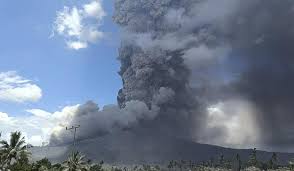Indonesia’s Mount Lewotobi Laki Laki volcano erupts, sending ash cloud 18 kilometers in air

Flores Island, Indonesia – July 7, 2025
Mount Lewotobi Laki Laki, located on Indonesia’s Flores Island, erupted early Monday, blasting a thick ash cloud 18 kilometers into the sky. The powerful explosion triggered emergency alerts, disrupted daily life, and forced authorities to act quickly to protect nearby communities.
Massive Ash Cloud Fills the Sky
The eruption occurred at 4:20 a.m. local time, according to Indonesia’s Geological Agency. A dense column of ash and volcanic gases shot into the upper atmosphere. The towering cloud was visible in satellite images and posed a threat to aviation in the region.
Officials raised the alert to the highest level. They ordered a 7-kilometer exclusion zone around the volcano. Dangerous pyroclastic flows — fast-moving clouds of superheated gas and debris — surged down the slopes.
“This eruption is significant and ongoing,” said Muhammad Wafid, head of Indonesia’s volcanology agency. “Our teams are monitoring the situation closely for any further changes.”
Villagers Evacuated, No Casualties So Far
More than 2,500 residents evacuated from villages near the volcano. Ashfall blanketed several communities, contaminating water supplies and reducing visibility. Emergency shelters were set up to house those displaced.
“We heard a loud boom before dawn, and the sky turned black with ash,” said Lusi Amano, a resident of Boru village. “We’ve packed what we could and are waiting to be moved to safety.”
Despite the eruption’s force, no injuries or deaths were reported. Health officials handed out masks to protect against inhaling ash particles. Local schools closed, and authorities asked farmers to avoid ash-covered fields.
Aviation Warnings and Flight Disruptions
Indonesia’s Transportation Ministry issued a red alert for aviation. Pilots received instructions to avoid the ash cloud, which had reached stratospheric altitudes. The Volcanic Ash Advisory Center in Darwin, Australia, confirmed the height and spread of the plume.
Some domestic flights were delayed or rerouted. While major international airports remained open, airports in Bali and Lombok continued to monitor the situation closely.
Volcanic ash poses serious risks to aircraft. It can clog jet engines, scratch windshields, and disable flight instruments.
The History and Nature of Mount Lewotobi
Mount Lewotobi is a twin-peaked stratovolcano. It consists of Lewotobi Laki Laki (“male”) and Lewotobi Perempuan (“female”) cones. The Laki Laki cone has been more active in recent years.
The volcano rises to 1,584 meters (5,197 feet). It is part of the seismically active Ring of Fire, which includes over 130 active volcanoes across Indonesia.
This eruption is the third major one in 2025, following activity in March and June. A previous event in November 2024 killed nine people, destroyed homes, and shut down air travel to Bali.
Geologists believe recent eruptions may result from tectonic pressure building beneath Flores Island. They also warn that more eruptions could occur.
Government Response and Safety Efforts
Indonesia’s disaster agency, BNPB, activated a large-scale emergency response. Teams provided supplies, cleared roads, and helped with evacuations. Medical staff treated minor injuries and smoke-related conditions.
“Our priority is to keep everyone safe,” said BNPB spokesperson Abdul Muhari. “We’re working with local leaders to coordinate evacuations and distribute aid.”
Authorities also warned of potential lahars, or mudflows. These can form when rain mixes with volcanic debris. The region is expected to see rain later this week, increasing that risk.
People were urged to stay inside, wear masks, and avoid riverbeds and slopes. Officials asked tourists to cancel trips to the area until conditions improve.
Scientists Call for Vigilance
Volcanologists continue to monitor the volcano using drones, satellite data, and seismic instruments. So far, activity levels remain high, and tremors continue to shake the area.
“Eruptions like this don’t usually happen in isolation,” said Dr. Made Gunarta, a geologist at Gadjah Mada University. “We expect more aftershocks or smaller eruptions as the volcano releases pressure.”
Gas emissions and ground deformation are being measured to predict future eruptions. The data will guide evacuation planning and hazard mapping.
Indonesia’s vast volcanic system makes monitoring difficult. But scientists say improved equipment and faster alerts are helping save lives.
Global and Regional Impact
The eruption drew international attention due to the extraordinary height of the ash plume. Clouds that reach the stratosphere can affect weather and global temperatures. They may reduce sunlight and cool surrounding regions.
Airlines in Southeast Asia are adjusting routes to avoid ash zones. Tourism companies are updating travel advisories and offering refunds to travelers.
Mount Lewotobi is just one of several volcanoes in Indonesia showing recent signs of unrest. Other active peaks, like Mount Semeru and Mount Merapi, have also erupted in the past year.
For now, Mount Lewotobi Laki Laki remains under intensive observation. Authorities are working around the clock to protect lives and property.






